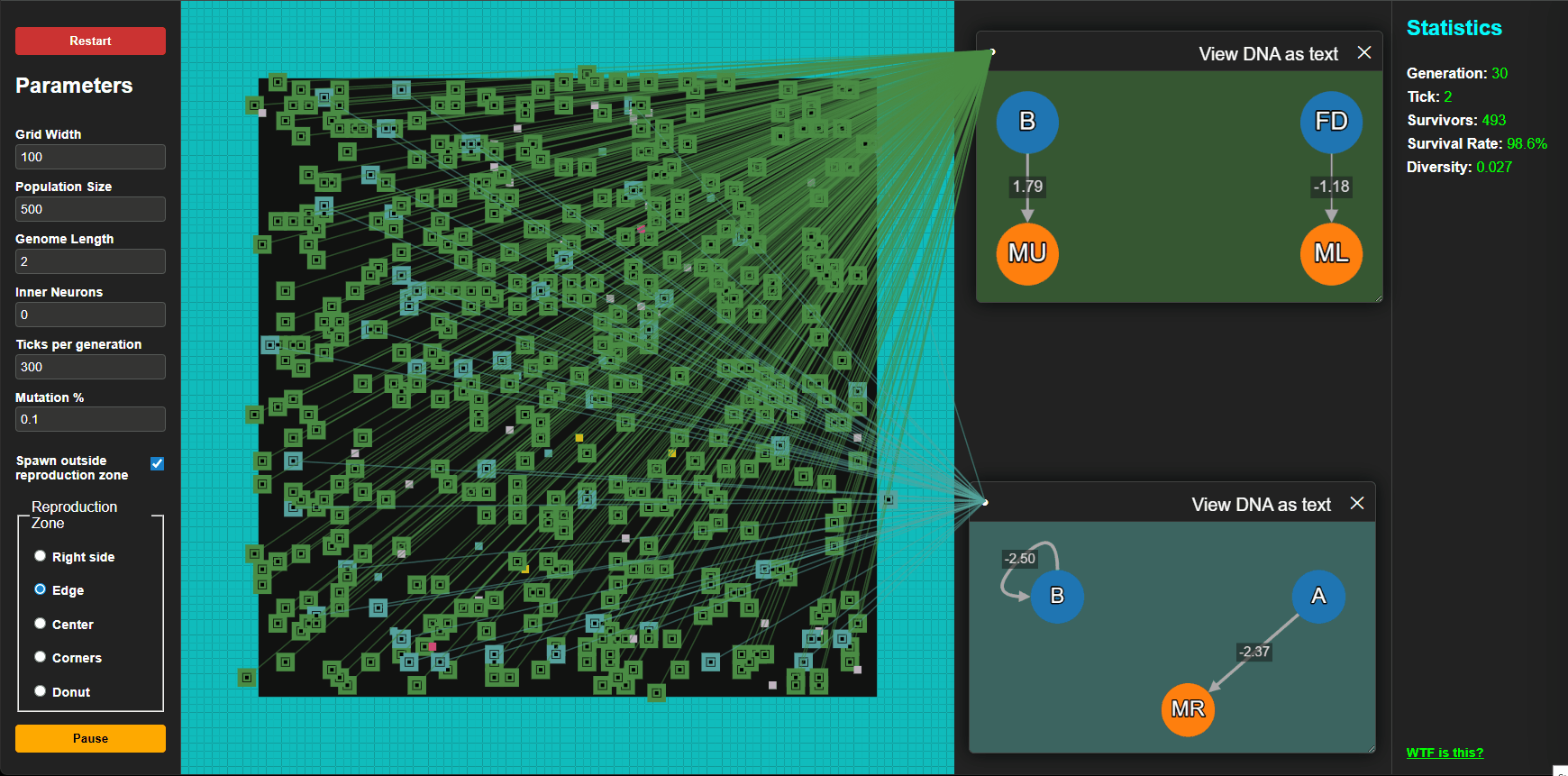2025-07-27: NCA Simulator
Published a new simulator
Since my last post, I’ve finally brought Neural Cellular Automata (NCA) to a presentable state.
NCA Simulator now runs live on Narco Neko Playground.

Overview
This simulation aims to do nothing… except invite you to ponder intelligence and evolution.
- Each colored cell represents an organism
- Each cell receives a DNA string at generation 0
- DNA defines a neural “brain” with:
- SENSOR nodes: measure environment
- INNER nodes: internal urges
- ACTION nodes: move or stay
- Colored area = Reproduction Zone
- Longer time in the zone = higher reproduction chance
- DNA mutates across generations
Quick Demo
Below is a comparison between generation 10 and generation 100+:
In this system, early evolution is mostly luck. Cells with working brains that happen to move toward the survival zone reproduce.
Later evolution is still luck — just more structured. Those born near the zone and able to hold position survive. Mutated misfits are left behind.
Slightly More Detailed Demo
This time the survival zone is set to Edge.
Genome length is set to 2 (just 2 brain connections per cell):
After ~30 generations:
Each cell has a DNA signature, based on structure only (not weights).
Cells with the same topology are grouped and colored identically.
Here we see two survival strategies:
Green cells (move left):
052343b3: Forward Density → (–1.18) → Move Left0020dbce: Bias → (+1.79) → Move Up
Blue-ish cells (move right):
0a2106a5: Age → (+2.37) → Move Right00000004: Bias → (–2.50) → Self (dud connection)
I hadn’t planned for negative weights, but a bug allowed them — giving rise to accidental strategies like “move left when forward is not crowded”
Even More Detailed Demo
To survive in a more complex zone like a donut, cells need more neural connections — in other words, more brain power. Adding a few INNER neurons also helps.
With more neurons, a wider variety of survival strategies emerges.
More unique DNA structures = more colors.
But with complexity comes opacity: it’s much harder to explain why a cell behaves a certain way without stepping through its logic.
Below is a breakdown of the DNA for one of the highlighted cells in the image
Legend: SENSOR → (weight) → TARGET
0722735d: Distance to South → (–0.25) → Move Down0712c958: Distance to South → (+1.43) → Inner Neuron 208230918: Distance to West → (–2.32) → Move Left0821ba14: Distance to West → (+1.13) → Move Right0822bba6: Distance to West → (+1.17) → Move Down021030c1: Touching Wall → (–1.55) → Inner Neuron 00310d141: Wall Proximity → (+1.59) → Inner Neuron 010236fdd: Inner Neuron 0 → (–0.32) → Move Left1020e6c7: Inner Neuron 0 → (+2.01) → Move Up10225410: Inner Neuron 0 → (–0.86) → Move Down111004b3: Inner Neuron 1 → (–2.41) → Inner Neuron 01210df0e: Inner Neuron 2 → (+1.86) → Inner Neuron 01210e26d: Inner Neuron 2 → (+1.92) → Inner Neuron 012125c4d: Inner Neuron 2 → (–0.70) → Inner Neuron 212129256: Inner Neuron 2 → (+0.36) → Inner Neuron 2
Yeah, nah… Good luck understanding that.
TODOs ( if I ever revisit this project )
- Prevent negative weights in encoded genes
- Add more interesting stats like gene entropy.
- Track gene statistics across generations and graph them.
- Add more SENSOR / ACTION node types
- Allow Reproduction Zone updates mid-simulation
- Add “Dead Zones” to reduce reproduction odds
Bonus pic for those who are still here



